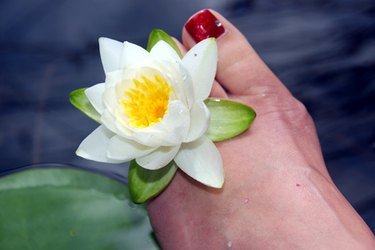
Water features look better and stay cleaner when aquatic plants are present. Every aquatic plant cleans water. They filter out minerals, carbon dioxide, ammonia, nitrates and nitrites. This filtering of the water helps keep the water clear and clean. If ornamental fish inhabit the pond, aquatic plants help create a habitable environment conducive to fish growth, health and protection. Aquatic plants convert carbon dioxide into oxygen which aerates the water. Fish thrive in oxygen-rich water. Clean water makes it possible for a homeowner to enjoy viewing the fish and plants within the water environment.
Oxygenator Plants
Video of the Day
These plants grow beneath the water's surface. They have a voracious appetite for the nutrients on which algae feed. When algae can't get the nutrients they need to survive, they die off. Algae are the green stuff that can make water look like pea soup. These plants clean carbon dioxide out of the water by converting it to oxygen. Oxygenators derive their name from the tiny air bubbles that emerge from their leaves and float to the surface. Place the roots of these plants in a pond plant basket and weight them down with marine safe rocks. Water crowfoot, water violet, monkey tail and parrots feather are typical oxygenator plants.
Video of the Day
Floating Plants
This type of plant floats on the surface of the water. It filters the water and provides shady protective cover for fish. This type of plant doesn't have to be rooted in a planter. When you cover 60 percent of your pond with these plants, the lack of sunlight will discourage algae blooms from occurring. The shade also helps keep water temperatures lower. Cooler water means more oxygen dissolution in the water. Water hyacinths and water lettuce are two of the more popular floating varieties.
Marginal Plants
These plants grow half in the water and half out of the water around the edges of a pond. They enjoy boggy or marshy areas. These plants filter the organic matter that collects along the outskirts of an aquatic environment. The parts of these plants that rise above the water often become the nesting areas for orioles and blackbirds. Cattails, iris, arum lily, marsh marigold and water mints thrive in these marginal locations.
Deep Water Aquatics
The water lily is the best known of most aquatic plants. These plants grow in the deepest parts of an aquatic environment. Their roots must be placed in planting baskets and weighted down at the bottom. They filter the organic matter that lines the floor of a fish pond or water garden. The water lotus is another deep-water aquatic that helps clean the water along the floor of a pond. These flower come in a variety of colors.